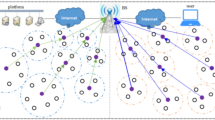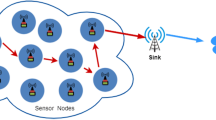Abstract
Wireless sensor network consists of sensor nodes with battery operated device. The key challenges in the wireless sensor network are energy consumption and routing optimization. This work presents the cluster based load balancing (CBLB) routing protocol. The proposed routing protocol is used to minimize the energy consumption and increase the routing performance. It avoids the routing robustness, delay and increases the delivery rate and network performance. In existing techniques, different routing protocols such as LEACH, HEED and MESTER were used to increase the network performance and to decrease the energy consumption. But these existing techniques did not satisfy the performance requirements of wireless sensor networks. Hence, there is a requirement to develop a technique that meets the QoS requirements and needs of wireless sensor network. The proposed CBLB routing protocol creates a cluster head in the decentralized network and the cluster head will be used to distribute the workload evenly to the cluster members for reducing the energy consumption in wireless sensor network. Experimental results analyze the performance of the proposed protocol with the different existing protocols. The proposed protocol achieves high throughput, delivery rate and reduces the energy consumption, delay and routing overhead.








Similar content being viewed by others
References
Al-Hamadi, H., & Chen, R. (2013). Redundancy management of multipath routing for intrusion tolerance in heterogeneous wireless sensor networks. IEEE Transactions on Network and Service Management, 10(2), 189–203.
Byun, H., & Junglok, Y. (2013). Adaptive duty cycle control with queue management in wireless sensor networks. IEEE Transactions on Mobile Computing, 12(6), 1214–1224.
Branch, J. W., Giannella, C., Szymanski, B., Wolff, R., & Kargupta, H. (2013). In-network outlier detection in wireless sensor networks. Knowledge and Information Systems, 34(1), 23–54.
Guo, S., He, L., Gu, Y., Jiang, B., & He, T. (2014). Opportunistic flooding in low-duty-cycle wireless sensor networks with unreliable links. IEEE Transactions on Computers, 63(11), 2787–2802.
Huang, P., Xiao, L., Soltani, S., Mutka, M. W., & Xi, N. (2013). The evolution of MAC protocols in wireless sensor networks: A survey. IEEE on Communications Surveys and Tutorials, 15(1), 101–120.
Nadeem, J., Abbas, Z., Fareed, M. S., Khan, Z. A., & Alrajeh, N. (2013). M-ATTEMPT: A new energy-efficient routing protocol for wireless body area sensor networks. Procedia Computer Science, 19, 224–231.
Liu, Y., He, Y., Li, M., Wang, J., Liu, K., & Li, X. (2013). Does wireless sensor network scale? A measurement study on GreenOrbs. IEEE Transactions on Parallel and Distributed Systems, 24(10), 1983–1993.
Pantazis, N. A., Nikolidakis, S. A., & Vergados, D. D. (2013). Energy-efficient routing protocols in wireless sensor networks: A survey. IEEE Transactions on Communications Surveys and Tutorials, 15(2), 551–591.
Ren, F., Zhang, J., Wu, Y., He, T., Chen, C., & Lin, C. (2013). Attribute-aware data aggregation using potential-based dynamic routing in wireless sensor networks. IEEE Transactions on Parallel and Distributed Systems, 24(5), 881–892.
Sha, K., Gehlot, J., & Greve, R. (2013). Multipath routing techniques in wireless sensor networks: A survey. Wireless Personal Communications, 70(2), 807–829.
Tyagi, S., & Kumar, N. (2013). A systematic review on clustering and routing techniques based upon LEACH protocol for wireless sensor networks. Journal of Network and Computer Applications, 36(2), 623–645.
Villas, L. A., Boukerche, A., Ramos, H. S., de Oliveira, H. A. B. F., de Araujo, R. B., & Loureiro, A. A. F. (2013). DRINA: A lightweight and reliable routing approach for in-network aggregation in wireless sensor networks. IEEE Transactions on Computers, 62(4), 676–689.
Wang, S. S., & Chen, Z. P. (2013). LCM: A link-aware clustering mechanism for energy-efficient routing in wireless sensor networks. IEEE Transactions on Sensors Journal, 13(2), 728–736.
Zhang, Z., Long, K., & Wang, J. (2013). Self-organization paradigms and optimization approaches for cognitive radio technologies: A survey. IEEE Transactions on Wireless Communications, 20(2), 36–42.
Zhang, D., Li, G., Zheng, K., Ming, X., & Pan, Z.-H. (2014). An energy-balanced routing method based on forward-aware factor for wireless sensor networks. IEEE Transactions on Industrial Informatics, 10(1), 766–773.
Author information
Authors and Affiliations
Corresponding author
Rights and permissions
About this article
Cite this article
Kowsalya, P.K., Harikumar, R. Performance Analysis of Adaptive Routing Structure for Wireless Sensor Network Based on Load Balancing. Wireless Pers Commun 90, 473–485 (2016). https://doi.org/10.1007/s11277-015-3058-y
Published:
Issue Date:
DOI: https://doi.org/10.1007/s11277-015-3058-y




